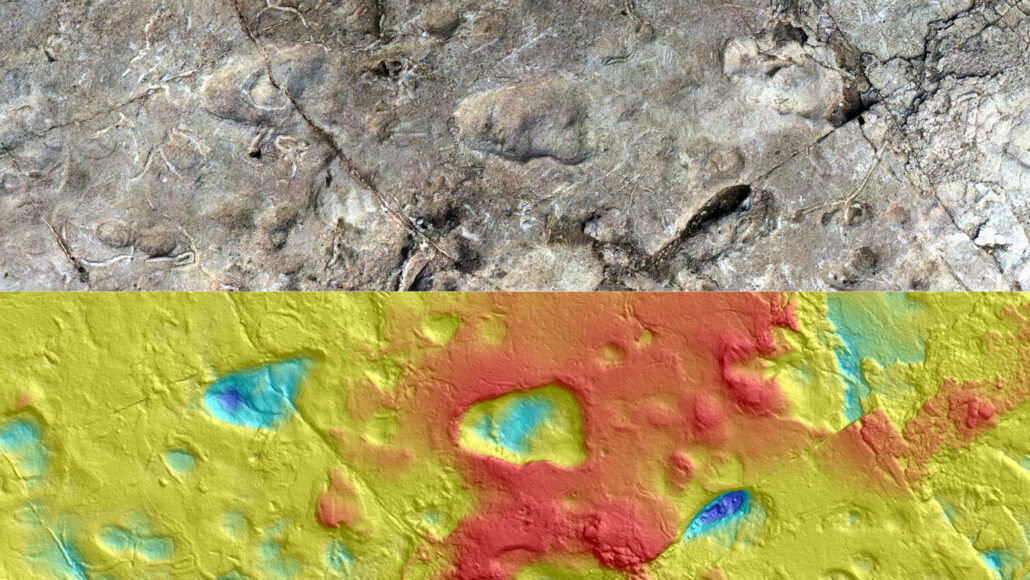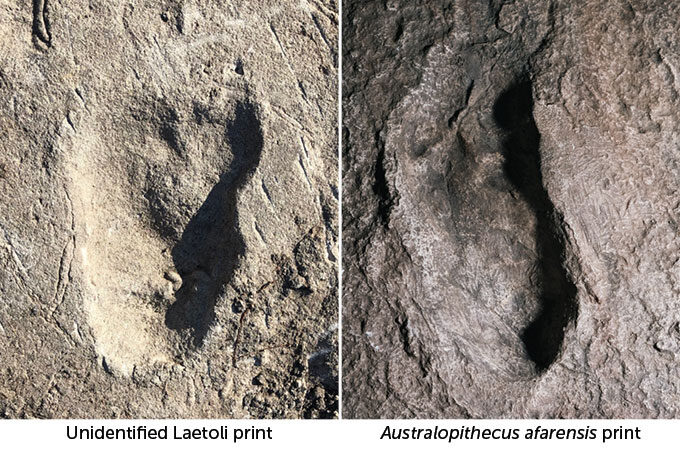
Those five ancient impressions, largely ignored since their partial excavation at Tanzania's Laetoli site in 1976, show hallmarks of upright walking by a hominid, a new study finds. Researchers had previously considered them hard to classify, possibly produced by a young bear that took a few steps while standing.
Nearby Laetoli footprints unearthed in 1978 looked more clearly like those of hominids and have been attributed to Lucy's species, Australopithecus afarensis (SN: 12/16/16). But the shape and positioning of the newly identified hominid footprints differ enough from A. afarensis to qualify as marks of a separate Australopithecus species, an international team reports December 1 in Nature.
"Different [hominid] species walked across this East African landscape at about the same time, each moving in different ways," says paleoanthropologist Ellison McNutt of Ohio University Heritage College of Osteopathic Medicine in Athens.
The species identity of the Laetoli printmaker is unknown.
Fossil jaws dating back more than 3 million years unearthed in East Africa may come from a species dubbed A. deyiremeda that lived near Lucy's crowd (SN: 5/27/15). But no foot fossils were found with the jaws to compare with the Laetoli finds. The 3.4-million-year-old foot fossils from an East African hominid that had grasping toes and no arch and the unusual fossil feet of 4.4-million-year-old Ardipithecus ramidus aren't a match either (SN: 3/28/12; SN: 2/24/21). So neither of those hominids could have made the five Laetoli prints, says McNutt, who started the new investigation as a Dartmouth College graduate student supervised by paleoanthropologist Jeremy DeSilva.

Because footprints of Lucy's species differed in some ways from the impressions uncovered two years earlier, many researchers doubted that a hominid had made the five-step trackway, some suspecting a bear instead.
The latest analysis refutes that suggestion, says paleoanthropologist Bernard Wood of George Washington University in Washington, D.C., who did not participate in the new study. "Not one, but two [hominids] left their mark at Laetoli 3.66 million years ago."
McNutt, deSilva and their colleagues fully excavated and cleaned the five Laetoli footprints in June 2019. Then they measured, photographed and 3-D scanned the ancient tracks. Print sizes indicated that they had been made by a relatively short individual, possibly one that had not yet reached maturity.
McNutt's group focused on two consecutive footprints that were particularly well-preserved. Foot shapes, proportions and stride characteristics of the Laetoli individual differed in various ways from those of A. afarensis individuals at the same site. The prints also didn't match those from modern juvenile black bears and modern chimps walking upright, present-day East African Daasanach people who typically don't wear shoes or preserved footprints of East African hunter-gatherers dating to between roughly 12,000 and 10,000 years ago (SN: 5/14/20)

On one step, the Laetoli individual's left leg crossed in front of the right leg, leaving a left footprint directly in front of the previous impression. People may cross-step in this way when trying to regain balance. But McNutt's team doubts that the newly analyzed Laetoli footprints represent smudged impressions made by an A. afarensis individual that cross-stepped, perhaps to stay upright. That's in part because footprints of Daasanach people walking as usual and then cross-stepping look largely the same, McNutt's team found. And bears and chimps assume a relatively wide stance due to knee and hip arrangements that prevent them from walking like the Laetoli individual and probably from cross-stepping, the scientists say.
Given that only two of the ancient footprints are complete enough to analyze thoroughly, the possibility that an ape other than a hominid made the Laetoli impressions can't be ruled out, says William Harcourt-Smith, a paleoanthropologist at Lehman College and the American Museum of Natural History in New York City who wasn't involved in the research. But evidence of cross-stepping points to a hominid track maker, he says.



Unknowingly they left some footprints 👣👣👣 and many many years later along came a scientist 🤪 who glanced down and had a eureka moment 🥳 for there was potential evidence of mankind's ancestral past.
As scientists 🤪 🤪 do, they analysed the BOLLOCKS out of their findings, and concluded, further research is required.